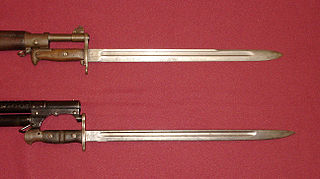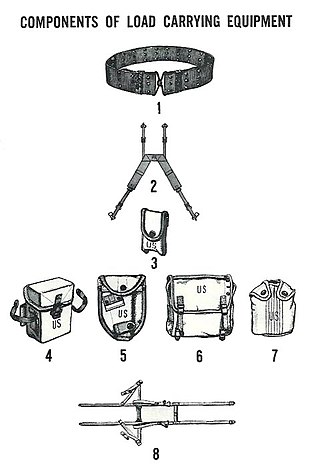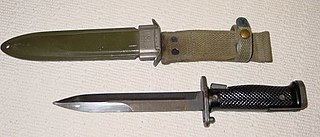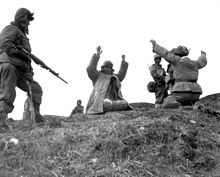
A bayonet is a knife, dagger, sword, or spike-shaped melee weapon designed to be mounted on the end of the barrel of a rifle, carbine, musket or similar long firearm, allowing the gun to be used as an improvised spear in close combats.
This page details tank production by the United States of America during World War II.

A trench knife is a combat knife designed to kill or incapacitate an enemy at close quarters, such as in a trench or other confined area. It was developed as a close combat weapon for soldiers attacking enemy trenches during the First World War. An example of a World War I trench knife is the German Army's Nahkampfmesser.

The M9 bayonet, officially known as the M9 Phrobis III, is an American multi-purpose knife and bayonet officially adopted in 1986 by the United States Armed Forces for the M16 rifle. Featuring a 7-inch (18 cm) blade and issued with a sheath designed to double as a wire cutter, the M9 bayonet is designed to function not only as a combat knife but also as a multi-tool, capable of serving as a wire cutter, metal slicer, bottle opener, and screwdriver.

The OKC-3S is a bayonet developed by the United States Marine Corps to replace the M7 bayonet and M9 bayonet as its service bayonet for the M16 family of rifles and M4 series carbine. This multipurpose bayonet provides greater durability than the M7 bayonet and it also functions as a fighting knife.

The M1917 bayonet was designed to be used with the US M1917 Enfield .30 caliber rifle, as well as seven different models of U.S. trench shotguns. The blade was 17 in (43 cm) long with an overall length of 22 in (56 cm). It will not fit the M1903 .30 caliber (Springfield) or the M1 .30 caliber (Garand) US service rifles as they have different bayonet ring (barrel) and attachment stud dimensions.

The 3-inch gun M1918 was a United States 3-inch anti-aircraft gun that entered service in 1918 and served until it was largely superseded by the 3-inch anti-aircraft gun M3 in 1930, though the M1918 remained with some National Guard units until early in World War II. The M3 was subsequently replaced by the M1 90mm AA gun early in World War II, primarily during 1942. The M3 3" gun was later adapted for the anti-tank role, serving as the main armament of the M10 tank destroyer during World War II.

The M6 Bayonet is a bayonet used by the U.S. military for the M14 rifle, it can also be used with the Mk 14 Enhanced Battle Rifle as well M39 Enhanced Marksman Rifle. It was introduced in 1957, at the same time as the rifle itself. It is the only bayonet made for the M14.

The M7 bayonet is a bayonet that was used by the U.S. military for the M16 rifle, it can also be used with the M4 carbine as well as many other assault rifles, carbines, and combat shotguns. It can be used as a fighting knife and utility tool. It was introduced in 1964, when the M16 rifle entered service during the Vietnam War.

The Model of 1905 bayonet was made for the U.S. M1903 Springfield rifle. This designation was changed to Model 1905 in 1917, and then to M1905 in 1925, when the army adopted the M designation nomenclature. The M1905 bayonet has a 16 in (41 cm) steel blade and a 4 in (10 cm) handle with wooden or plastic grips. The bayonet also fits the U.S. M1 Garand rifle. From 1943 to 1945, a shorter, 10 in (25 cm), bladed version was produced with either black or dark red molded plastic grips, and designated the M1 bayonet. A number of M1905 bayonets were recalled from service, their blades cut down, and reissued as M1 bayonets. But the cut down version was not used in Vietnam.

The M-1956 load-carrying equipment (LCE), also known as the individual load-carrying equipment (ILCE), was developed by the U.S. Army and first issued in the early 1960s. The M-1956 LCE was designed to replace the M-1945 Combat Pack, the M-1923 cartridge belt, the M-1936 pistol belt and the M-1937 BAR magazine belt. The M-1956 LCE was designed to be quickly configured, using no tools, to accommodate various mission and ammunition loads. The M-1956 LCE remained in service through the 1980s and set the standard for future United States military load-carrying equipment.

The M5 Bayonet was adopted by the U.S. military in 1953 to replace other bayonets for the M1 Garand rifle. It uses the M8A1 scabbard.

The M3 trench knife or M3 fighting knife was an American military combat knife first issued in March 1943. The M3 was originally designated for issue to soldiers, not otherwise equipped with a bayonet. However, it was particularly designed for use by forces in need of a close combat knife, such as Airborne Units and Army Rangers, so these units received priority for the M3 at the start of production. As more M3 knives became available in 1943 and 1944, the knife was issued to other soldiers such as Army Air Corps crewmen and soldiers not otherwise equipped with a bayonet, including soldiers issued the M1 carbine or a submachine gun such as the M3 submachine gun "grease gun".
Dalian Rail Transit, according to the order of construction, includes the Dalian trams, the Dalianren light rail and the Dalian Rapid Transit. The Dalian Rapid Transit system is divided into the Kuaigui and Ditie. The Kuaigui is the overground system mainly running in the suburban area, while the Ditie is the underground system operating in the urban area. Announcements of the DRT are made in Mandarin and English. As of November 1, 2015, DRT has about 170 kilometers of track.












